Elemental, divine, magical, astronomical, magnetic or mechanical forces, to name just a few, were omnipresent in the life of early modern people. With the growing number of books made for the purpose of pedagogy and scientific communication, and the important role of images in these books, the question of how one could bring these forces to the page became progressively more important. How does one, for example, visualize the force or strength of heat that could mechanically turn a grilling spit, or the force required to lift a heavy object? Throughout the early modern period a variety of visual techniques were deployed to depict these forces, taking up visual traditions and inventing new modes of representation. From diagrams illustrating a specific theory to spectacular machine drawings, this section demonstrates some of these approaches in the fields of physics, mechanics, astrology, naval tactics, and acoustics.
A diagrammatic depiction of magnetic force by means of arrow is provided in Athanasius Kircher’s Magnes (Rome, 1654; 1641 1st ed.). This image visualizes the extension of the invisible magnetic force. The Jesuit author aims at proving the so-called “sphere of activity” to be elliptical instead of circular, which can be observed in the image by looking at the circumference of the arrows. The arrows fixed to the magnetic poles C and D of a spherical piece of magnet are actually compass needles. Kircher, both as experimenter and a trained mathematician, transforms his compass needles experiment into an abstract diagram composed of geometrical shapes.
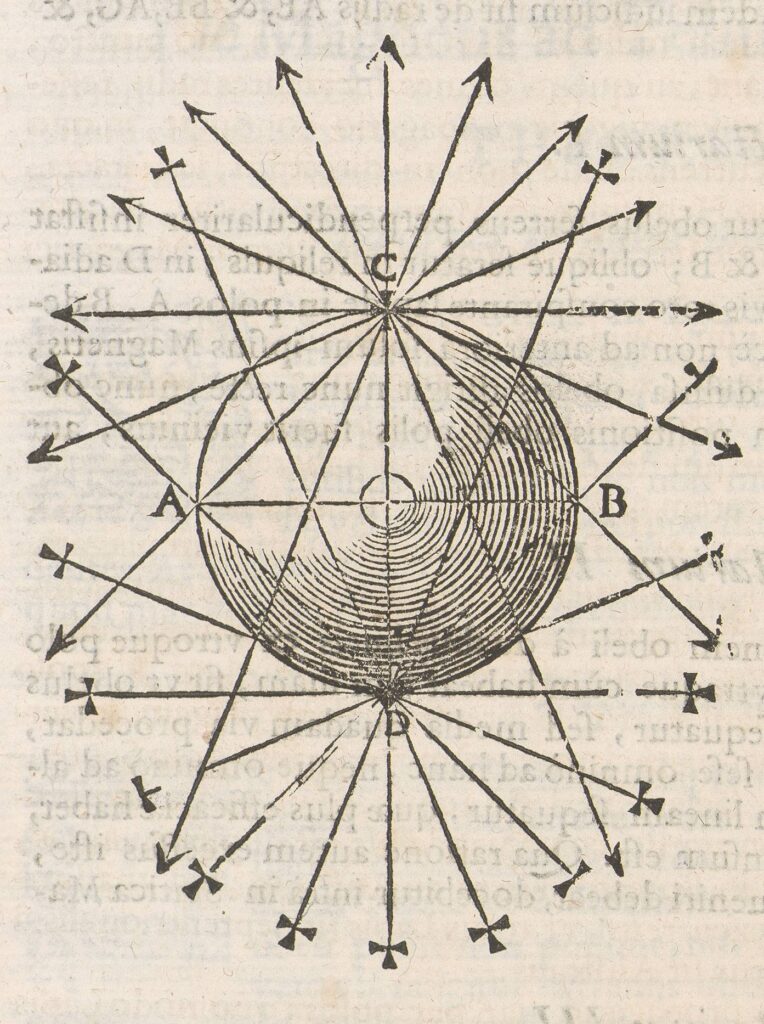
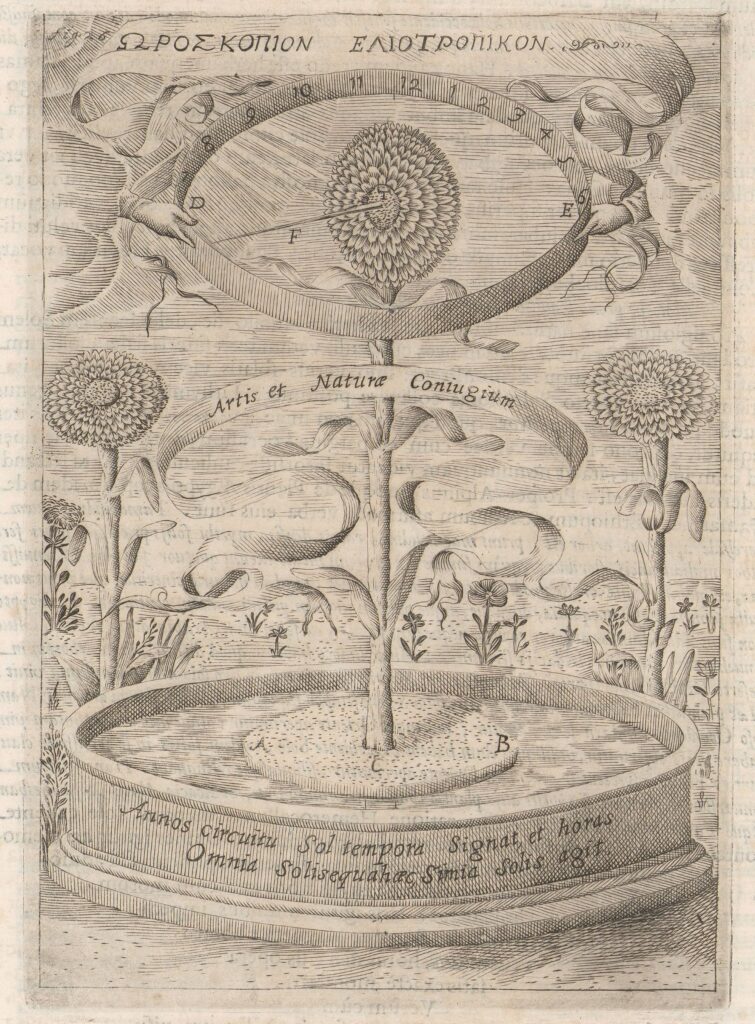
Kircher did not limit his conception of magnetism to what is usually encompassed by this concept today, but saw it as a universal life force. To illustrate the “magnetic” relationship, or sympathy, between the sun and the plant kingdom, he included this engraving of a sunflower clock. A sunflower is placed on a cork floating in water, and as the flower turns to the sun, a connected pointer indicates the time.
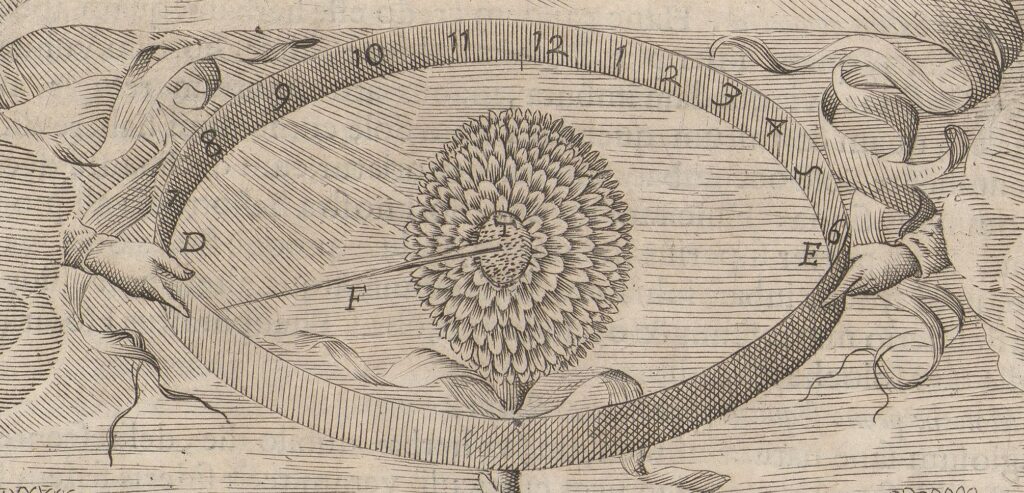
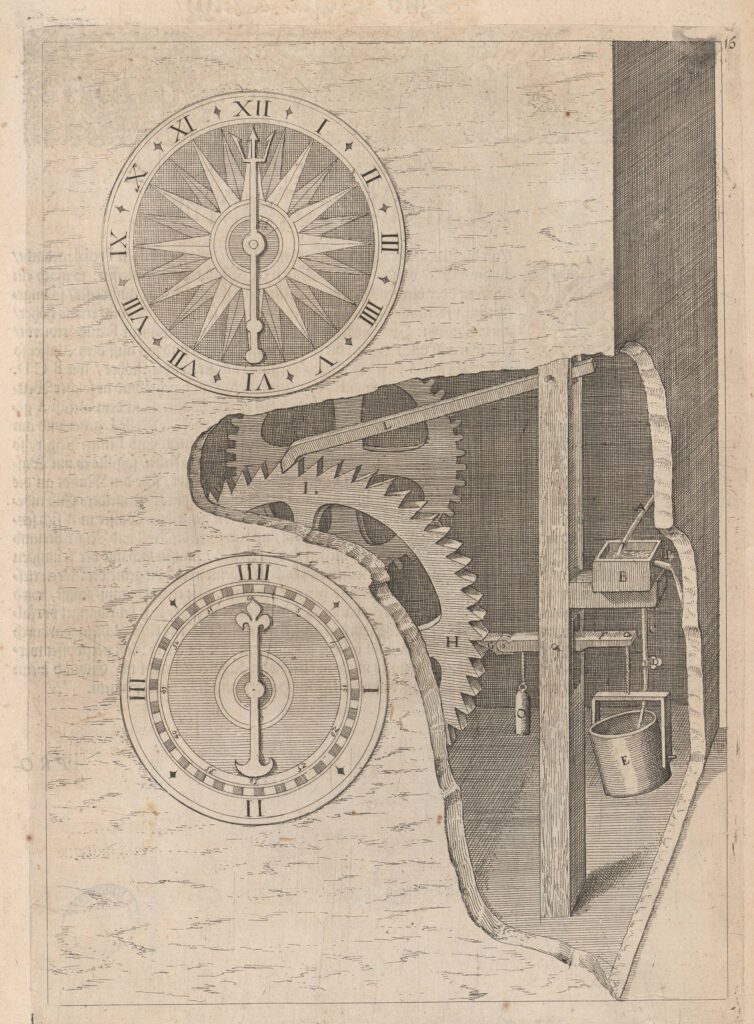

A different way of depicting force is found in the book Von Gewaltsamen bewegungen (Frankfurt, 1615) of the engineer Salomon de Caus. In this image he shows how to construct a clock continuously operated by running water. Behind the effortlessly looking clocks lies a complex mechanism. Instead of laying the machine completely bare, De Caus uses different levels of depth to allow the viewer to understand the workings of the clock—one must pierce through the walls, where the water mechanism and gears are hidden.
With their playful approach to what is hidden and what is seen, De Caus’s images are something to marvel at, a visual spectacle, fitting the baroque aesthetics that would take hold of Europe in the seventeenth century. In the image to the right, a single man is able to lift a stone many times bigger than himself by the power of mechanics.
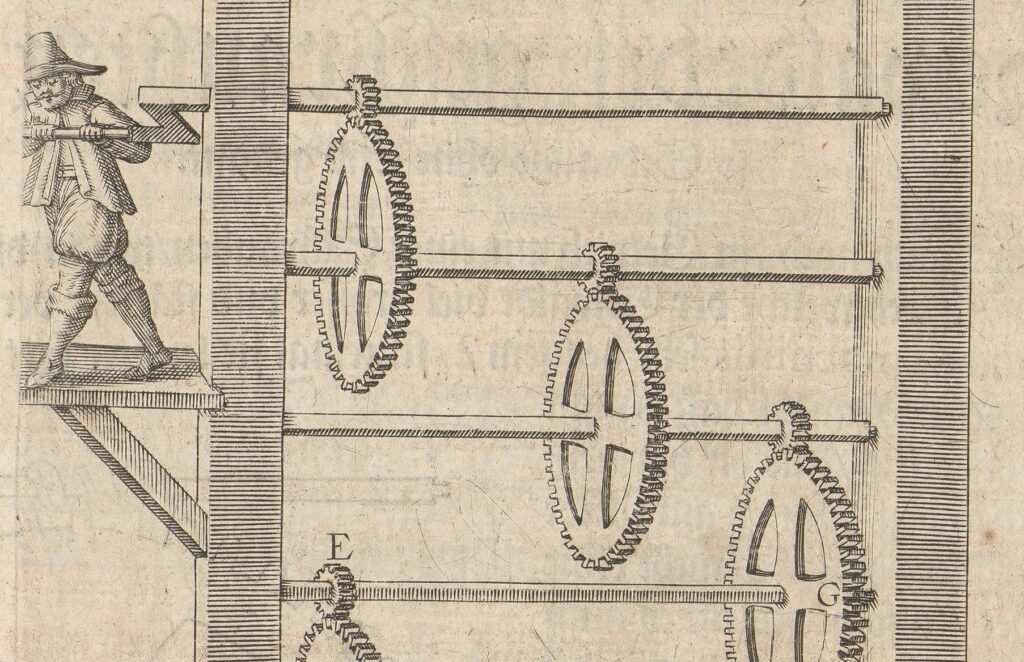
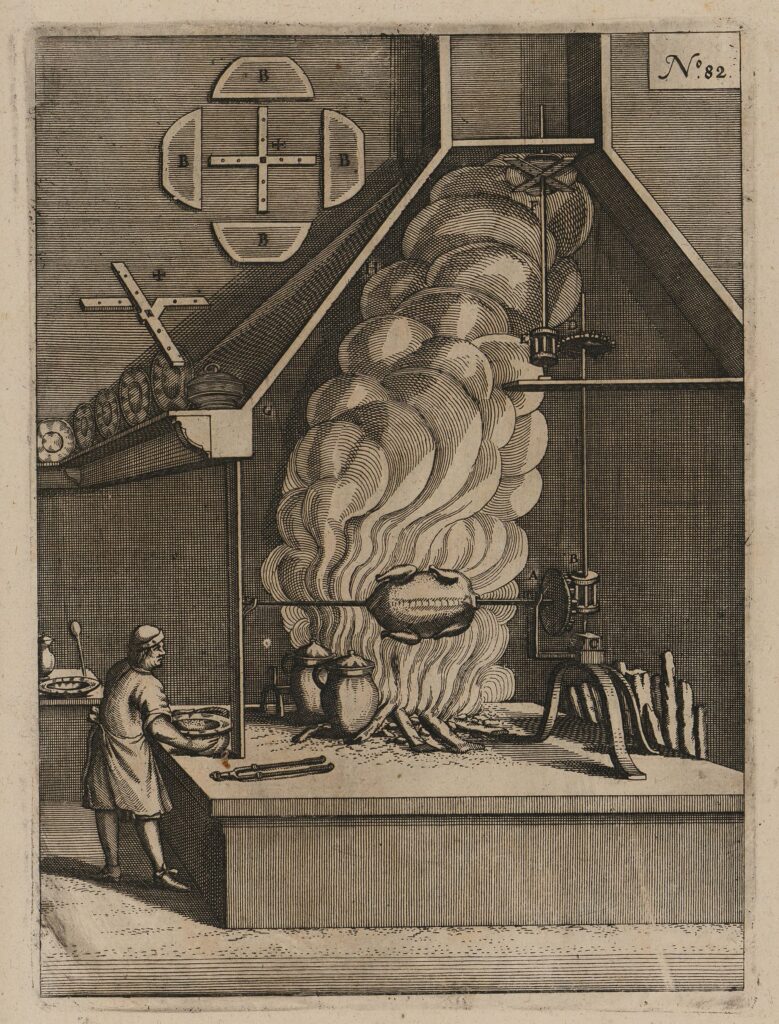
Like De Caus’s machines, the elaborate inventions from Georg Andreas Böckler’s Theatrum Machinarum (Nuremberg, 1673) are marvelous, effortless and useful. This particular machine enables you to evenly roast a chicken, freed from the burden of manually turning the spit. Operated by the smoke of the fire, this machine operates itself by several gears.
The center of the image is taken up by the flowing lines of the fire and its smoke. The artist used cross-hatching to suggest depth in the smoke fumes. As Böckler explains in his brief description, the smoke fumes set the wheel F in motion, which turns wheel E, that is connected to the horizontal wheel D, etc. The construction of the wings that catch the smoke is further illustrated in the top left of the image.
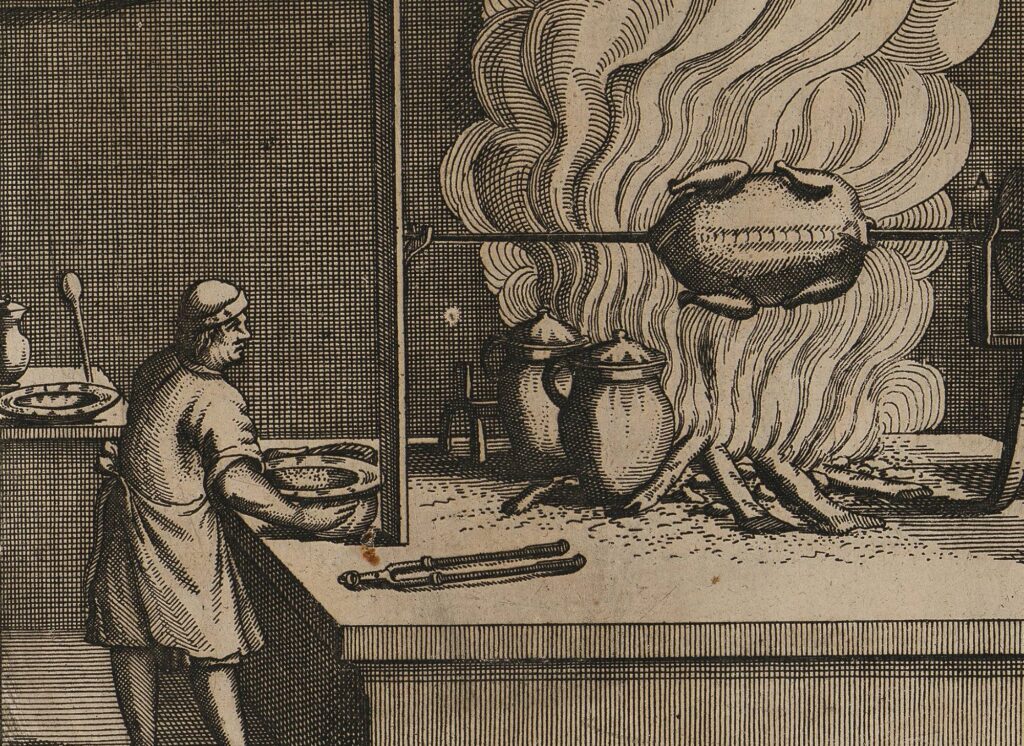

Other machines in Böckler’s book incorporate a larger role for human power, but in most cases humans blend into a mechanical construction. There is little visual distinction between the force brought forth by humans and the force brought forth by water, as in this image that depicts how to raise water in order to set a water wheel in motion.
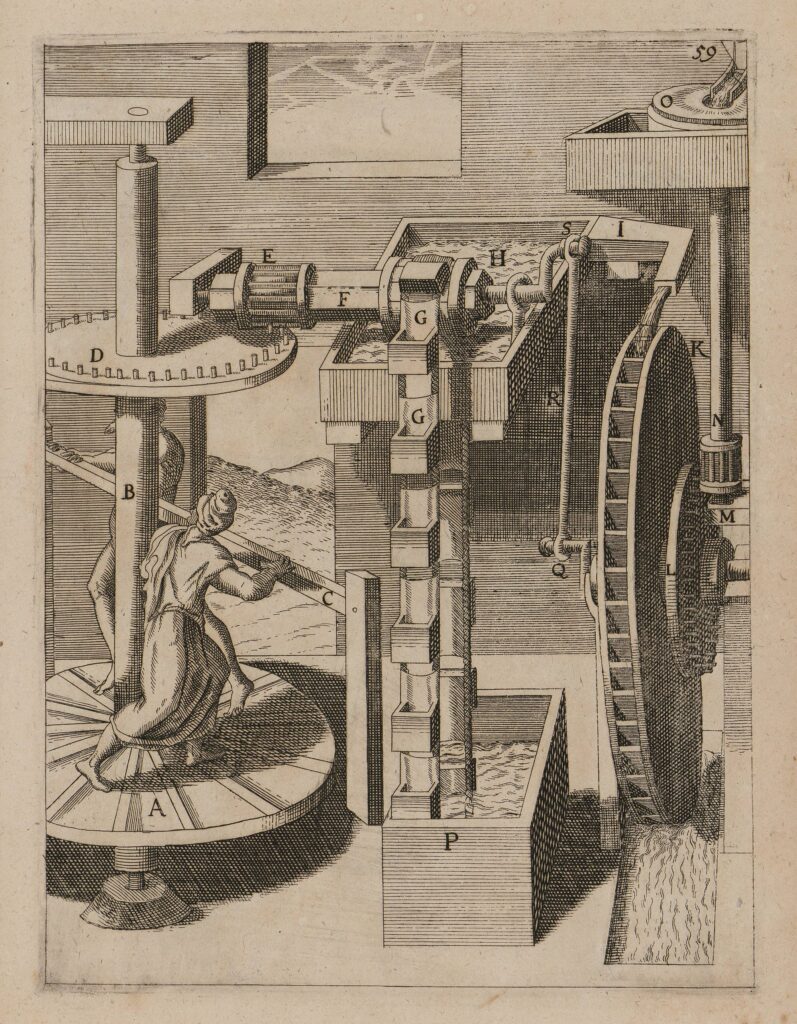
Another device operated by the elements is the Aeolian harp, depicted here by Kircher in his book Phonurgia nova (Kempten, 1673). Named after the Greek god of the Wind Aeolus, Aeolian harps are self-playing instruments operated by wind, consisting of a sounding board with strings, shown in the middle. Kircher added two pipes that maximize the capture of wind.
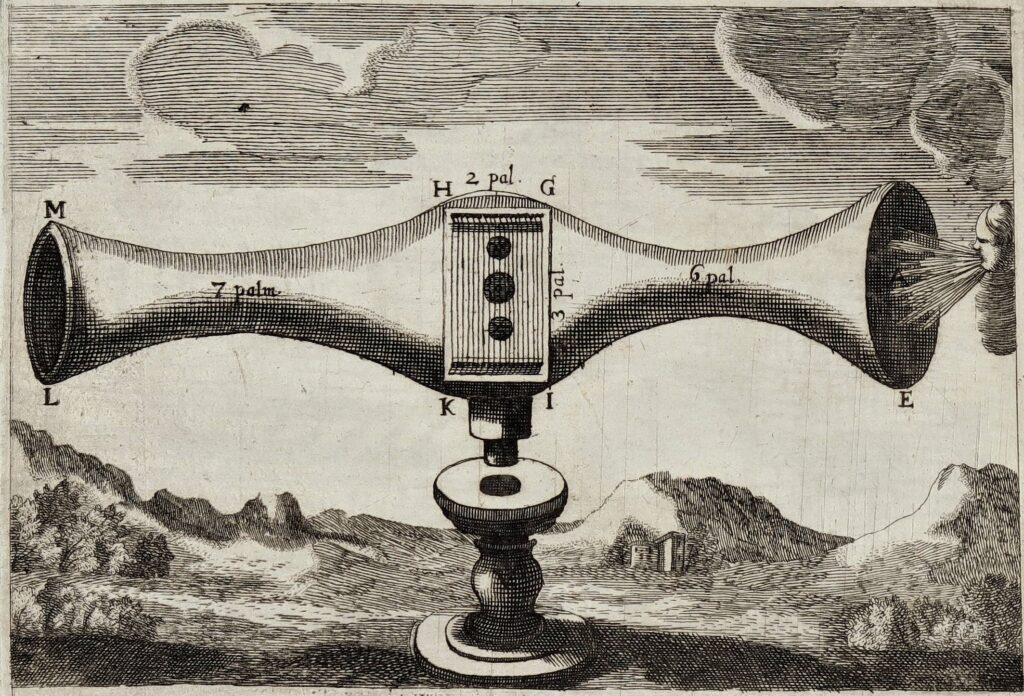
The figure blowing into the tube could be the personification of Aeolus himself, whose bellows of wind are represented by forceful lines. Although a tool of engineering, the mythical landscape suggests an element of naturalness present in the instrument, as no human intervention is needed to bring forth audible harmonies.

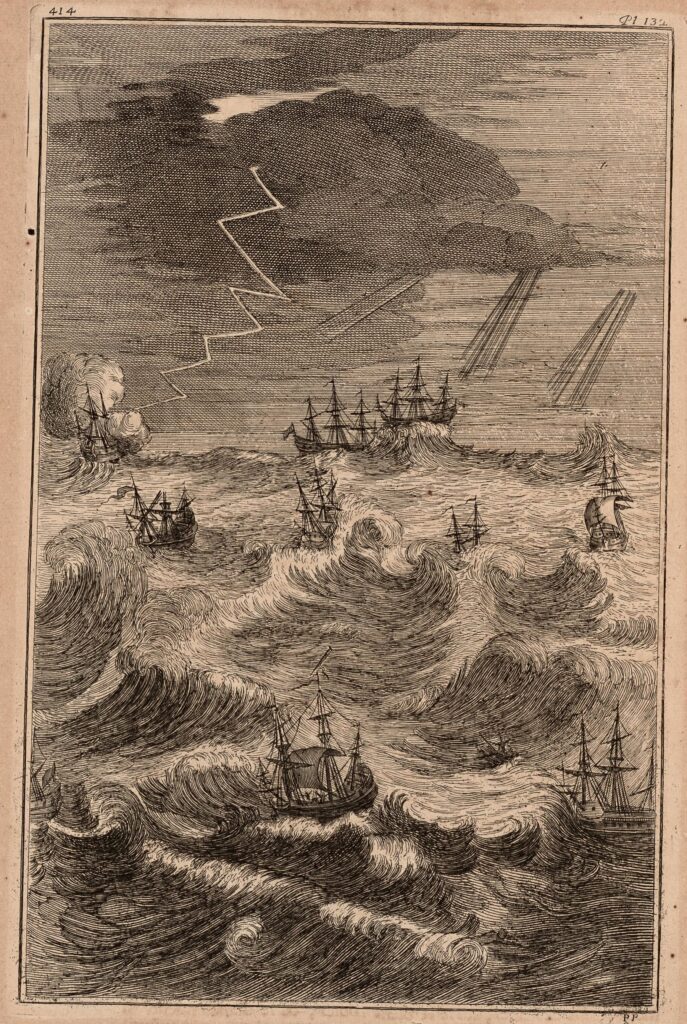
The forces of the elements are less Arcadian in this depiction of the storm by the Jesuit Paul Hoste. “An army should never stay on the sea during a storm,” Hoste wrote in his L’Art des Armées Navales (Lyon, 1697). In his book on naval tactics he was resolute on representing the dangers of the sea, including this engraving illustrating what awaits those captains who find themselves in a storm. Water, lightning and clouds all create here a powerful image of the perils of seafaring.
Throughout his book, Hoste emphasized the role of order and mathematics in the naval arts. Besides elaborate pictorial depictions, he included various rules in diagrammatic form to illustrate the mathematical principles behind seafaring. The book showed readers that what makes a good ship can be calculated and measured.
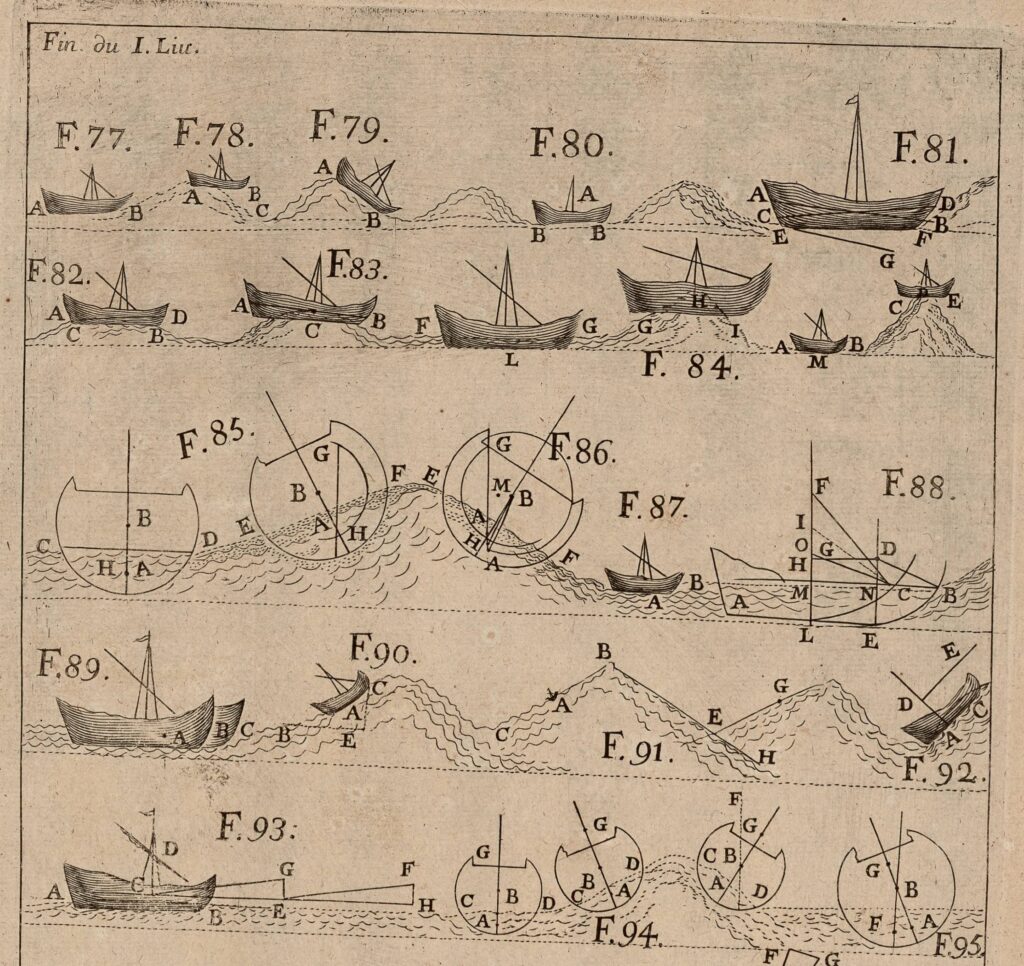
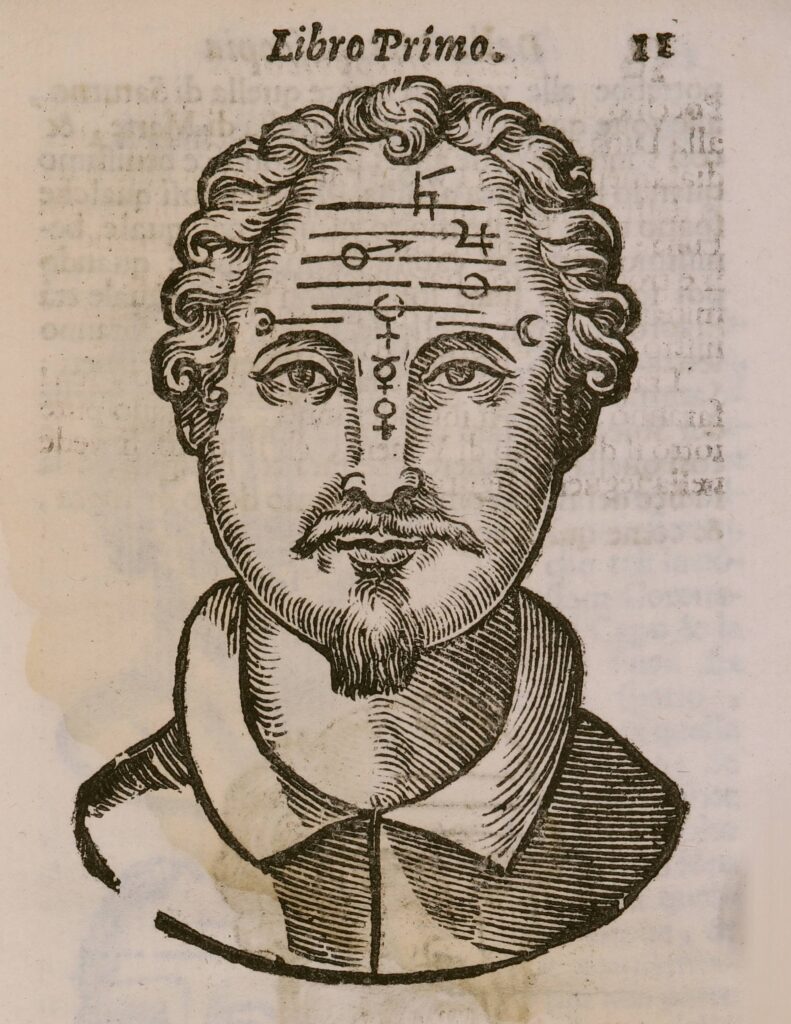
Finally, Ciro Spontone’s depictions of the locations of astrological forces present in the human face make clear that even something as abstract and immaterial as astrology can be mapped onto the human body with great precision. In this book La Metoposcopia (Venice, 1654) Spontone gives a guide on how to interpret facial lines based on astrological principles.
Relying extensively on images to show his readers how they might put this art into practice, Spontone depicts face after face, each with a different constellation of lines. In the image from the opening of his book shown above, he locates the position of the planetary constellations on the human face. Later, he explains how one can recognize the lines of Jupiter and Venus on your neighbor (below left), or the lines of Saturn and Mars on your spouse (below right). As Spontone explains in his book, if the line of Saturn joins the lines of Mars, you are hard-working, ingenious, and pertinacious. If however these lines are oblique as illustrated in the image in the top right, make sure to run away, as they signify accidents and misfortune. This man is most likely a murderer, blasphemist, and adulterer, so watch out!
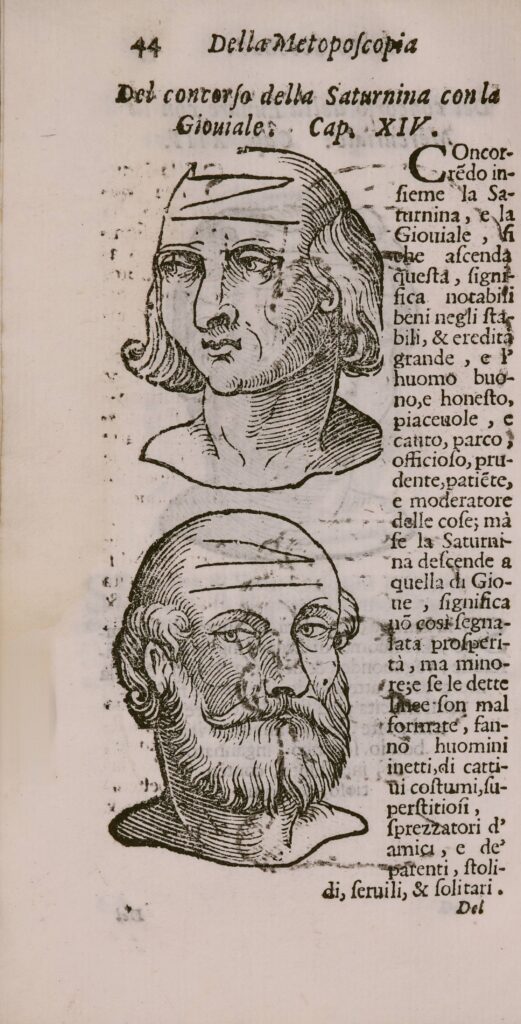
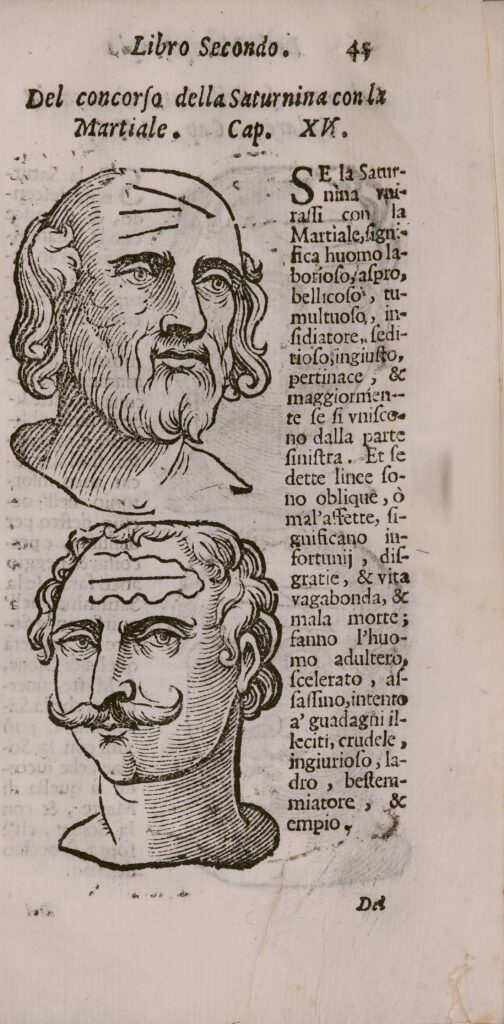
Sources:
- Böckler, Georg Andreas. Theatrum Machinarum Novum. Das ist: Neu-Vermehrter Schauplatz der Mechanischen Künsten. Nuremberg: Fürsten, 1673. Gh-BOE 1133-2730 raro VIII [Kubikat; Digitized Version]
- De Caus, Salomon. Von Gewaltsamen bewegungen: Beschreibung etlicher, so wol nützlichen alß lustigen Machiner beneben Unterschiedlichen abriessen etliher Höllen od. Grotten vnd lust Brünne[n]. Frankfurt: Pacquart, 1615. Gh-CAU 6905-2150 raro VIII [Kubikat; Digitized Version]
- Hoste, Paule.L’Art DesArméesNavales, Ov Traité Des EvolutionsNavales. Qui Contient Des Regles Utiles Aux Officiers Généraux, & Particuliers d’une Armée Navale. Lyon : Anisson and Posuel, 1697. Hm 7000-2970 raro VIII [Kubikat; Digitized Version]
- Kircher, Athanasius. Magnes Sive De Arte Magnetica Opvs Tripartitvm […]. Rome, Mascardi, 1654. BHR: Zs-KIR 1051-2540 raro VIII [Kubikat; Digitized Version]
- Kircher, Athanasius. Phonurgia nova sive conjugium mechanico-physicum artis & naturae paranympha phonosophia concinnatum, Kempten: Dreher, 1673. Zx 370-2730 raro VI [Kubikat; Digitized Version]
- Spontone, Ciro. La Metoposcopia Ouero Commensvratione delle linee della fronte. Venice: Turini, 1654. Zs-SPO 7593-2540 raro I [Kubikat; Digitized Version]
Further reading:
- Ferreiro, Larrie D. Ships and Science: The Birth of Naval Architecture in the Scientific Revolution, 1600-1800. Cambridge, MA: MIT Press, 2007.
- Gilman, Sander L. Seeing the Insane. Lincoln, NE, University of Nebraska Press, 1996).
- Hankins, Thomas and Robert Silverman, Instruments and Imagination. Princeton: Princeton University Press, 1995.
- Lazardzig, Jan.Theatermaschine und Festungsbau: Paradoxien der Wissensproduktion im 17. Jahrhundert. Berlin: Akademie Verlag, 2007.
- Roßbach, Nikola. Poiesis der Maschine: Barocke Konfigurationen von Technik, Literatur und Theater. Berlin: Akademie Verlag, 2013.
- Sander, Christoph. Magnes: Der Magnetstein und der Magnetismus in den Wissenschaften der Frühen Neuzeit. Leiden: Brill, 2020.